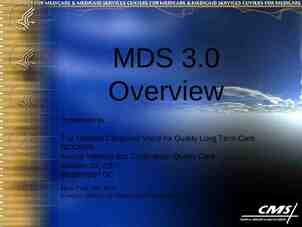DICOM Structured Reporting Current Status and Role in the
17 Slides197.50 KB
DICOM Structured Reporting Current Status and Role in the Electronic Patient Record Harry Solomon Co-chair, DICOM WG1 - Cardiovascular Information Solomon, DICOM SR European Society of Cardiology 2 September 2001 page 1
What is DICOM Structured Reporting? A means of encoding structured information hierarchical tree of content items, using DICOM object syntax For vendor-independent exchange between systems leveraging the DICOM object management infrastructure Providing unambiguous documentation of meaning text, categorical codes, numeric measurements, inter-item relationships For the image-intensive clinical environment careful attention to clinical observation context robust references to DICOM images, waveforms Solomon, DICOM SR European Society of Cardiology 2 September 2001 page 2
Structured Reporting is Not. DICOM SR is not just “reports” – any structured data exchanged between systems – measurements, analyses, sonographer notes . DICOM SR is not Structured Data Entry – Hierarchical pull-down menus to support report creation is often denoted “structured reporting” – DICOM does not standardize applications or data entry techniques – Structured data entry is a valuable means of creating SR content in certain circumstances Solomon, DICOM SR European Society of Cardiology 2 September 2001 page 3
Where Can Cardiology Use SR? Clinical Reports (cath, echo, nuc, etc.) – to go along with our pretty DICOM pictures Analyses of raw image and waveform data – backing up the Clinical Report Documentation of the procedure – provide context for the raw data and analyses Input to a clinical database – for patient care over time, or outcomes analysis Solomon, DICOM SR European Society of Cardiology 2 September 2001 page 4
Cath Lab Example Procedure Log Cath Lab Report Patient 67 yr old male, history of Ref prior ECG report Procedure Ref Log Narrative . Findings Hemodynamic Ref HD Report Narrative . Angiographic 70% stenosis . Ref image Intervention Stent placed in LAD Ref image Complications Summary 11:10 Patient prepped 11:19 Percutaneous entry 11:23 XA image acquired 11:27 HD waveform acquired 11:30 XA image acquired 11:47 PTCA 11:59 XA image acquired 12:02 HD waveform acquired 12:21 Pt released to holding 12:24 HD Report Hemo Report Baseline Ref waveform Measurements Post-intervention Ref waveform Measurements Derived measurements Ref waveform
Structured Reporting is the glue that makes possible construction of an electronic patient record for cardiology Solomon, DICOM SR European Society of Cardiology 2 September 2001 page 6
DICOM SR Status Work began in 1994 – Championed by Dr. Dean Bidgood Supplement 23: Structured Reporting - April 2000 – Defined general format for SR objects DICOM header, hierarchical tree of content items Concepts represented by coded terminology using external (non-DICOM) lexicons [e.g., Reed codes, SNOMED anatomy, ICD-9/10 diagnosis or procedure codes, SCP-ECG lead IDs] – Defined general classes of clinical reports – Extremely flexible Solomon, DICOM SR European Society of Cardiology 2 September 2001 page 7
The Problem of Flexibility A document creator can put in anything in any structure A document reader must handle every possible document Need to constrain the SR content to enable meaningful receiving applications – Structure – Content Solomon, DICOM SR European Society of Cardiology 2 September 2001 page 8
DICOM SR Status Supplement 53: Content Mapping Resource - May 2001 – Defined general structure for templates: document patterns – Mechanism for terminology context groups: constrained vocabulary subsets – Fundamental templates for documenting clinical context and for basic reports – DICOM lexicon for vocabulary not externally available Solomon, DICOM SR European Society of Cardiology 2 September 2001 page 9
So Theoretically . DICOM Structured Reporting is ready to be implemented for cardiology! But Pragmatically Solomon, DICOM SR European Society of Cardiology 2 September 2001 page 10
Issues for Cardiology SR Uses not well covered by “clinical report” model – Procedure logs, preliminary measurement reports Many ways to encode the same information – Need consistent approach for interoperability Need tailored subset of SR for developers – Reduce the learning curve Need Cardiology-specific SR Templates and consensus Terminology Solomon, DICOM SR European Society of Cardiology 2 September 2001 page 11
Cardiology SR Efforts Supplement 66: Cath Lab SR (WG1) – – – – – Procedure Log Hemodynamics Report ECG Report Quantitative Analysis Report Cath Lab Report Supplement 26: Ultrasound SR (WG12) – Echocardiography Report Both to be released for Public Comment this autumn Solomon, DICOM SR European Society of Cardiology 2 September 2001 page 12
Procedure Log Issues Structure - flat Ordering - strictly time sequential Linkage of events - associative Procedure Step / Action ID SOP Class - distinct from reports Remote entries - new Application Event Logging Service Class Solomon, DICOM SR European Society of Cardiology 2 September 2001 page 13
Hemodynamic Report Issues SOP Class - Cath Lab Measurements (together with QCA, QVA, IVUS measurements, etc.) – Distinction from report titles Structure - deep hierarchy Terminology - post-coordinated, context from hierarchy Solomon, DICOM SR European Society of Cardiology 2 September 2001 page 14
Hemo Report Structure Hemo Report CONTAINER Baseline Phase CONTAINER Post-Intervention Phase CONTAINER Post-Contrast Phase CONTAINER Patient State CONTAINER Arterial Measurements CONTAINER Patient State CONTAINER Arterial Measurements CONTAINER Anatomic Location L Fem Art Anatomic Location Aorta Systolic Pres Systolic Pres Diastolic Pres Diastolic Pres Mean Pres Mean Pres Ventricular Measurements CONTAINER Gradient Measurements CONTAINER
Find out more http://www.pixelmed.com/srbook.html – David Clunie’s excellent introduction to DICOM SR ftp://medical.nema.org/medical/dicom/supps – text of draft supplements http://www.dicomwg12.org/structured reporting – echocardiography SR subscribe to WG1 email list – send request to how [email protected] Solomon, DICOM SR European Society of Cardiology 2 September 2001 page 16
Thank you Questions? mailto://[email protected] Solomon, DICOM SR European Society of Cardiology 2 September 2001 page 17






















